
Front-end web development makes a website visually engaging and user-friendly. It helps build responsive websites, interactive features, and optimise user experiences for desktop and mobile platforms, enabling users to navigate seamlessly across devices.
The best frameworks for front-end web development include React, Angular, Vue.js, Svelte, Next.js, and Nuxt.js. These frameworks help focus development by providing pre-built functions and components that developers can use to build responsive, dynamic websites.
The programming languages used for front-end web development include HTML, CSS, JavaScript, TypeScript, Dart, JSX, and SASS/SCSS. These languages are important for creating structured, styled, and interactive user interfaces on the web.
To develop the front-end of a website, steps to follow include planning and designing, coding the structure, adding interactivity with JavaScript, testing, and deploying the website. These structured processes are carried out to ensure the website loads quickly and provides a smooth user experience.
According to a report by Clutch titled "2023 Web Development Industry Survey," published in Clutch (2023), there are over 4.5 million front-end developers globally, responding to the growing demand for interactive web design and mobile responsiveness.
What Is Front-End Web Development?
Front-end web development refers to the creation of the visual and interactive aspects of a website or web application. This includes everything the user interacts with directly in the browser, such as the layout, design, and functionality. It involves using a combination of programming languages, frameworks, and tools to build responsive, user-friendly, and accessible websites.
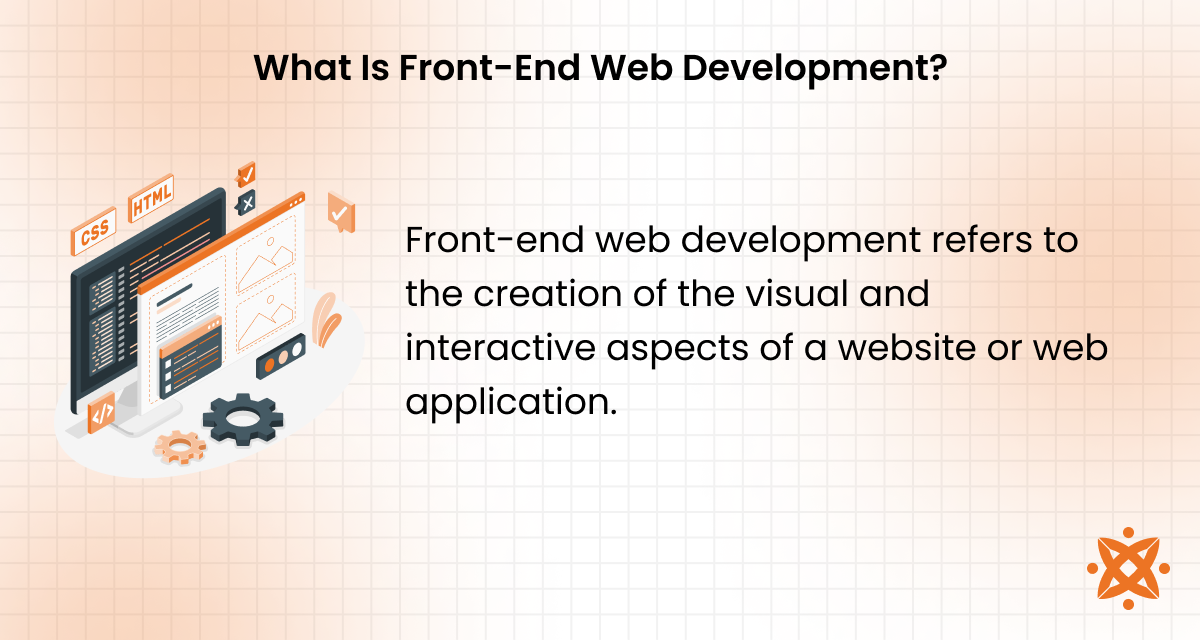
According to a report by the National Association of Software and Services Companies (NASSCOM), titled "Global Software Development Trends," 2023, the number of front-end developers globally continues to grow, with millions of developers working in this field to meet increasing demand for interactive and mobile-responsive websites.
Front-end development is important because it shapes the user's experience and determines how a website functions on different devices and browsers. Good front-end development ensures that websites load quickly, are easy to navigate, and provide a smooth experience across various platforms.
Use cases for front-end web development include building e-commerce websites, blogs, social media platforms, and enterprise-level applications that rely on user interaction.
What Is A Front-End Web Developer?
A front-end web developer is a professional who specialises in creating the client-side of websites and web applications. Their role is to build the parts of a website that users interact with directly, ensuring the site is visually appealing, responsive, and functional across devices and browsers.
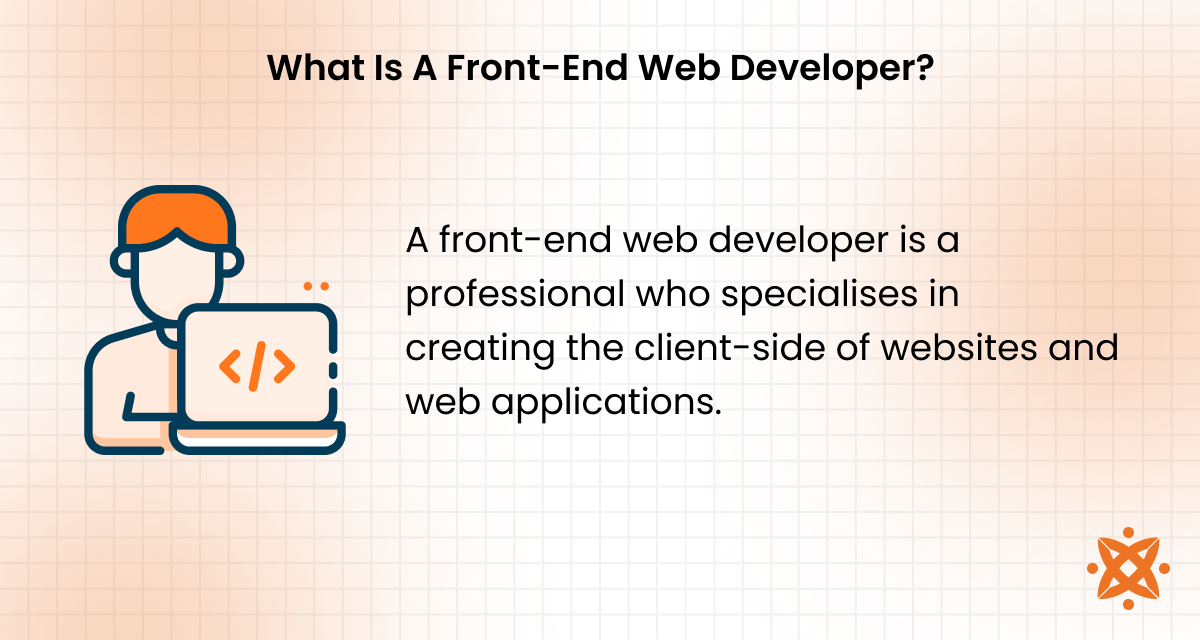
Front-end web developers work with technologies like HTML, CSS, JavaScript, and various frameworks to design, implement, and optimise websites. They ensure that all visual elements of the website work seamlessly and are accessible to users. Their tasks often include translating design mockups into code, developing interactive features, and troubleshooting issues related to performance or user experience.
A front-end web developer should have a strong grasp of web design principles, knowledge of programming languages (HTML, CSS, JavaScript), and familiarity with frameworks and tools such as React, Angular, or Vue.js.
While a formal degree may not always be necessary, a degree in computer science or a related field, along with experience in web development projects, is highly valued. Understanding UI/UX design principles and keeping up with the latest trends in front-end development is critical for success in this role.
What Are The Best Frameworks For Front-End Web Development?
The best frameworks for front-end web development include React, Angular, Vue.js, Svelte, Next.js, and Nuxt.js. These frameworks simplify the process of building complex user interfaces by providing reusable components, enhanced performance, and better maintainability.
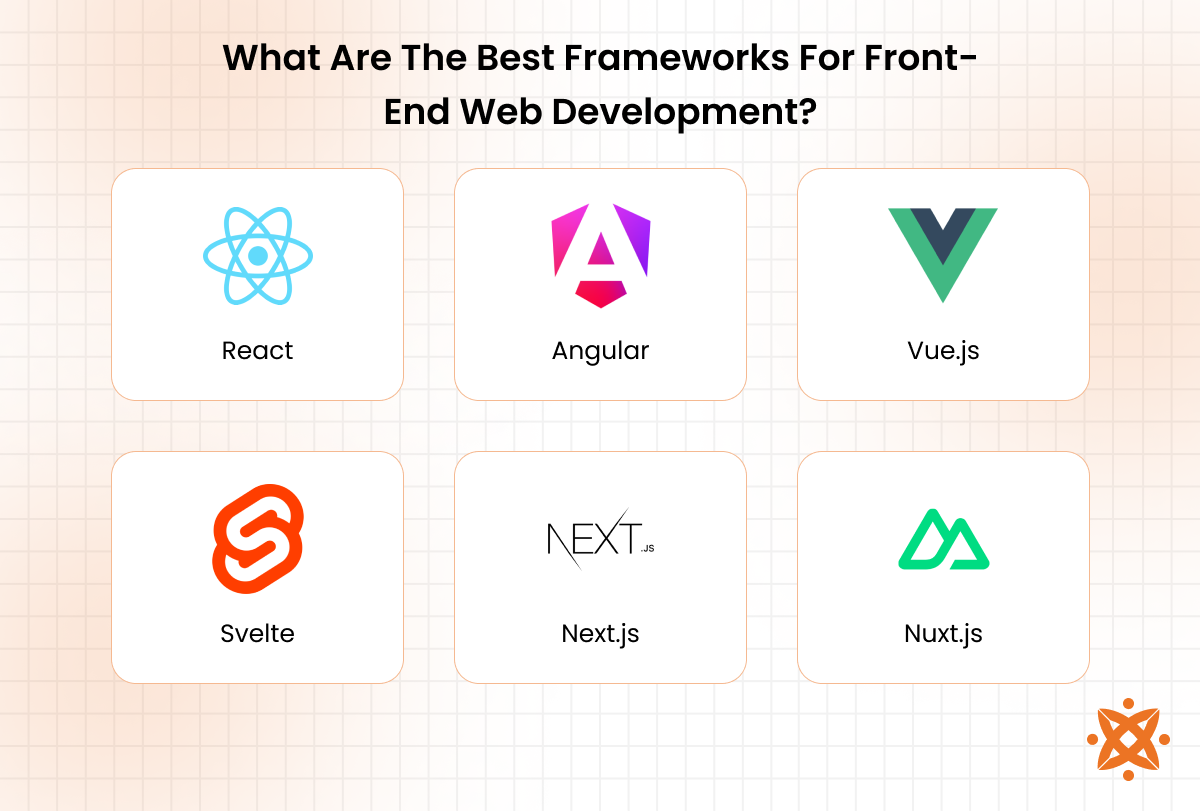
The best frameworks for front-end web development are explained below:
- React: React is a JavaScript library for building user interfaces, developed by Facebook in 2013. It uses JavaScript and JSX (a syntax extension for JavaScript) to create dynamic and interactive components. React is widely regarded as beginner-friendly due to its component-based architecture. You need Node.js and npm (Node Package Manager) to work with React.
- Angular: Angular is a TypeScript-based open-source web application framework developed by Google in 2010. It allows developers to build dynamic single-page applications using TypeScript, HTML, and CSS. Angular is highly structured, which may have a steeper learning curve compared to other frameworks. Developers need to install Node.js and the Angular CLI to get started.
- Vue.js: Vue.js is a progressive JavaScript framework for building user interfaces, created by Evan You in 2014. Vue is known for its simplicity and flexibility. It primarily uses JavaScript, HTML, and CSS for development. Vue is often considered easier to pick up for beginners due to its detailed documentation and a less opinionated structure. Vue requires Node.js and npm.
- Svelte: Svelte is a JavaScript framework that shifts much of the work to compile time, resulting in faster runtime performance. It was developed by Rich Harris in 2016 and does not use a virtual DOM. Svelte uses JavaScript, HTML, and CSS, and its syntax is clean and simple. It's easier for beginners, and to start working with it, you need the Svelte compiler.
- Next.js: Next.js is a React-based framework that supports server-side rendering and static site generation. Developed by Vercel, it simplifies building React applications with powerful features like automatic code splitting and optimised performance. Next.js uses JavaScript (React) and TypeScript. It's relatively easy for developers familiar with React, and tools such as Vercel and npm are needed to use it.
- Nuxt.js: Nuxt.js is a framework built on top of Vue.js, enabling server-side rendering for Vue applications. Developed by the team at Nuxt Labs in 2016, it is perfect for building static websites and universal applications. Nuxt.js uses Vue.js, JavaScript, and TypeScript. It offers an easy learning curve for Vue.js users, and you need Node.js to get started with Nuxt.
What Programming Languages Are Used For Front-End Web Development?
The programming languages used for front-end web development include HTML, CSS, JavaScript, TypeScript, Dart, JSX, and SASS/SCSS. These languages are fundamental in creating dynamic, interactive, and visually appealing websites. Below is a breakdown of each language.
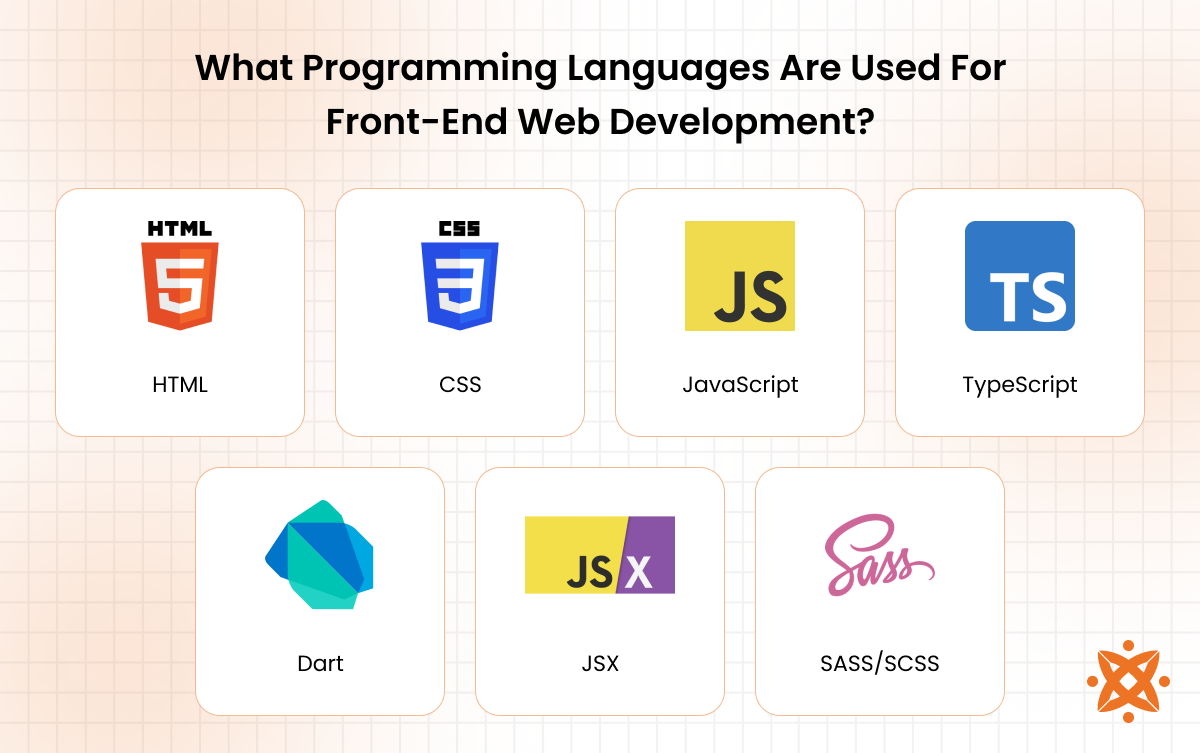
The programming languages used for front-end web development are:
- HTML: HTML (HyperText Markup Language) is the foundation of web content, used to structure a web page and its elements. HTML provides the basic structure by defining headings, paragraphs, links, images, and other content types. Its simplicity is a major advantage, but it lacks advanced functionality, which is why it is often used in conjunction with other languages like JavaScript and CSS.
- CSS: CSS (Cascading Style Sheets) is used for styling HTML content, controlling the layout, colours, fonts, and spacing. CSS allows developers to create responsive and visually appealing websites. While CSS gives full control over the layout, complex designs may be time-consuming and challenging to implement, especially for beginners.
- JavaScript: JavaScript is a dynamic scripting language that enables interactivity on web pages. It allows for tasks like form validation, animation, and updating content without refreshing the page. JavaScript is versatile and widely supported, but result in performance issues when not optimised properly. It is essential for building modern, interactive web applications.
- TypeScript: TypeScript is a superset of JavaScript that adds static typing to the language. It allows developers to catch errors during development before the code runs in the browser. TypeScript enhances JavaScript's functionality by improving code readability and maintainability. The downside is that it introduces an additional learning curve for developers new to the language.
- Dart: Dart is an object-oriented programming language developed by Google, often used for building mobile and web applications. Dart is commonly paired with the Flutter framework for mobile app development, but it is also suitable for front-end web development. Dart's performance is impressive, but its relatively low popularity and smaller developer community can limit support and resources.
- JSX: JSX (JavaScript XML) is a syntax extension for JavaScript, commonly used with React to describe what the UI should look like. JSX allows developers to write HTML structures directly within JavaScript code, improving readability and ease of development. However, JSX requires a transpiler like Babel to convert it into regular JavaScript, making it slightly more complex than using pure HTML and JavaScript.
- SASS/SCSS: SASS (Syntactically Awesome Stylesheets) and its newer version, SCSS (Sassy CSS), are extensions of CSS that allow for more advanced styling features, such as variables, mixins, and nesting. They make large, complex projects easier to manage and maintain. SASS/SCSS adds powerful features, but it requires a preprocessor and additional setup, making it slightly more complicated to integrate into a workflow.
How To Develop The Front-End Of A Website?
To develop the front-end of a website, steps to follow include planning and designing, coding the structure, adding interactivity with JavaScript, testing, and deploying the website. These steps ensure the creation of a functional, visually appealing, and user-friendly website.
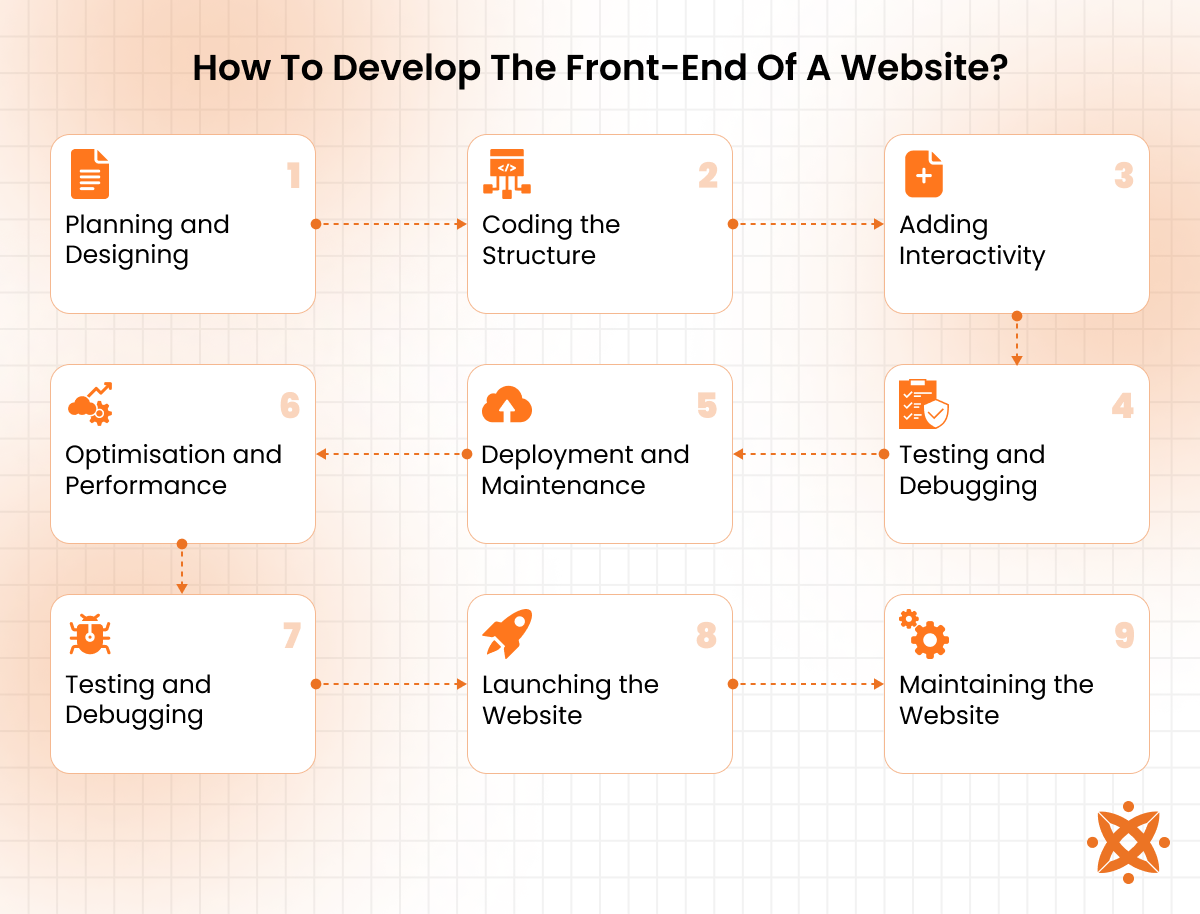
To develop the front-end of a website, the steps to follow are:
Step 1: Planning and Designing
The first step in developing the front-end of a website is planning and designing. During this stage, you define the website's purpose, identify the target audience, and create a layout. Wireframes or mockups are often created to visualise the website structure before development begins.
This step also involves choosing colour schemes, fonts, and overall design elements that align with the website's goals. It is essential to prioritise user experience (UX) to ensure that visitors will have a smooth, intuitive interaction with the site.
Step 2: Coding the Structure
The second step in front-end development is coding the structure of the website. This involves using HTML to create the basic structure, such as headings, paragraphs, and navigation. HTML serves as the foundation for the site and dictates how content is displayed.
Once the HTML structure is in place, CSS is used to style the page. CSS allows you to control the layout, colours, fonts, and overall design of the website, ensuring that it matches the mockups or wireframes created in the first step.
Step 3: Adding Interactivity
The third step is adding interactivity to the website, primarily through JavaScript. This step involves writing scripts that allow users to interact with the page, such as submitting forms, clicking buttons, or navigating through different sections without refreshing the page.
JavaScript is used to enhance the user experience by providing real-time updates and feedback. For example, animations, dynamic content loading, and user input validation all rely on JavaScript to create a responsive and engaging experience.
Step 4: Testing and Debugging
The next step is testing and debugging, which ensures that your website functions correctly across different devices and browsers. This phase involves checking for bugs, ensuring compatibility, and fixing any issues that may arise.
To perform effective testing, you use tools like browser developer tools, cross-browser testing tools, and performance testing tools. Debugging allows you to identify and resolve issues that could affect user experience, ensuring that the site is responsive and functional.
Step 5: Deployment and Maintenance
Once testing is complete, the next step is deployment, where the website is launched to a live server. This involves moving the website from a development environment to a production server, making it accessible to users worldwide.
Post-launch, the website requires continuous maintenance. This includes updating content, ensuring compatibility with new browsers, fixing any bugs, and improving performance. Regular maintenance keeps the website running smoothly and ensures it stays relevant over time.
Step 6: Optimisation and Performance
After deployment, optimisation plays a crucial role in improving the website's performance. This involves tasks like reducing load times, optimising images, and improving server response times. Optimising a website enhances user experience and increases the likelihood of visitors staying longer.
Performance monitoring tools track the website's speed and identify areas for improvement. Regular optimisation ensures the website runs smoothly and efficiently, even as user traffic grows.
Step 7: Testing and Debugging
Testing and debugging ensure that the website functions as intended across different devices and browsers. This step involves checking for issues like broken links, incorrect formatting, and functionality problems. It's essential to use both manual and automated testing methods to uncover potential errors.
Once identified, debugging tools and techniques are applied to fix these issues. Thorough testing improves the overall quality and performance of the website, ensuring it meets user expectations.
Step 8: Launching the Website
Launching the website marks the transition from development to a live environment. This step involves setting up the website on a server and ensuring it is accessible to users. It's crucial to double-check all configurations and ensure that no errors remain before the site goes live.
After launch, it's important to monitor the website's performance and ensure it remains stable. Regular checks for broken links, slow load times, or security issues are necessary to keep the site running smoothly.
Step 9: Maintaining the Website
Website maintenance is essential to ensure the website stays up-to-date and secure. This involves regularly updating the content, fixing bugs, and implementing new features as needed. Keeping everything current ensures the user experience remains optimal and prevents security vulnerabilities.
Regular backups should also be done to prevent data loss. Performance monitoring tools can help identify any issues, such as slow loading times, and improve site functionality over time.
What Is The Difference Between Front-End Web Development And Back-End Web Development?
The main difference between front-end and back-end web development is that front-end focuses on the visual and interactive aspects of a website, while back-end deals with the server-side logic, databases, and overall functionality that supports the website.
Front-end development includes everything that users see and interact with, such as layout, buttons, and content. Back-end development handles data management, server configuration, and integration with databases to ensure the site's functionality.
In addition to these core distinctions, front-end developers are concerned with the aesthetics and usability of the website, while back-end web development focuses on the performance, security, and data structure behind the scenes. Back-end developers manage APIs, authentication, and server configurations, ensuring that the website's core features work as intended.
What Is The Difference Between Front-End Web Development And Web Development?
The main difference between front-end web development and web development is that front-end web development specifically focuses on the design, structure, and interactive aspects of a website, while web development encompasses both front-end and back-end development.
Front-end developers work on what users directly interact with, such as layout, content, and user experience. Web development, on the other hand, includes both the client-side (front-end) and server-side (back-end) aspects, which together create a fully functional website.
In addition to this primary difference, front-end web development is concerned with the user interface, usability, and visual design, while web development also includes tasks such as database management, server configuration, and API integration. Web development covers the entire scope of website creation, including both the user-facing and behind-the-scenes functionality that supports the website's operations.
How To Choose The Right Front-End Web Developer?
To choose the right front-end web developer, the factors to consider are experience, skills, portfolio, communication, project management ability, collaboration, and adaptability. These elements ensure that you hire someone capable of building a website that aligns with your business goals and expectations.
To choose the right front-end web developer, the factors to consider are:
- Experience: Seek developers with extensive hands-on experience in front-end technologies. They should demonstrate problem-solving abilities and an understanding of design principles. A seasoned developer can anticipate challenges and create high-quality solutions.
- Skills: Ensure proficiency in HTML, CSS, and JavaScript. Familiarity with popular frameworks like React or Angular is a strong advantage. A well-rounded skill set ensures a smoother development process.
- Portfolio: Review their past projects for quality and variety. A diverse portfolio shows they can adapt to different styles and requirements. Make sure their work aligns with your vision.
- Communication: Good communication is crucial for understanding project goals. The developer should be able to explain complex concepts clearly. Effective communication ensures smooth project collaboration.
- Project Management Ability: Look for developers who manage their tasks efficiently. They should meet deadlines and handle multiple priorities. Strong project management minimises delays and improves the development process.
- Collaboration: The developer should be comfortable working with designers, back-end developers, and other stakeholders. Strong teamwork ensures that all parts of the project come together, and collaboration also helps in problem-solving.
- Adaptability: Technology changes rapidly, so an ideal developer must keep up with new trends. They should be open to learning and integrating new tools. A willingness to adapt ensures that your website stays modern and functional.
If you're looking for a reliable and skilled front-end web developer, consider Intelivita for your project. With years of experience, a proven track record, and a team of experts, Intelivita is one of the best providers of front-end web development services in London and nearby areas.
Our deep understanding of both design and functionality will ensure your website stands out and meets the highest standards. Let us help you build a dynamic, user-friendly website with top-tier front-end development expertise.
What Is The Cost Of Front-End Web Development?
The average cost of front-end web development ranges from £1,000 to £30,000, depending on several factors such as the complexity of the project, the developer's experience, and the region. A simple website with a few pages will be at the lower end of the scale, while complex, dynamic websites with custom features or integrations can push the cost higher.
According to a report by Clutch titled "How Much Does Web Development Cost?", 2023, the average cost for a mid-range web development project in the UK ranges from £9,000 to £15,000.
Factors influencing the cost include the type of website, design elements, custom functionalities, and whether the project involves integrations with third-party services. Websites with advanced features such as e-commerce, interactive elements, or high traffic capacity require more extensive development and testing, which increases the cost. Moreover, the timeline and the need for ongoing support after launch can also impact pricing.
What Are The Best Practices For Front-End Web Development?
The best practices for front-end web development include clean code, responsiveness, performance optimisation, cross-browser compatibility, and version control. Adhering to these principles is vital for delivering high-quality websites that meet user expectations and business goals.
The best practices for front-end web development are:
- Write Clean, Readable Code: Clean code is easy to maintain and understand. It involves using meaningful variable names, proper indentation, and comments where necessary. A clean codebase ensures efficient collaboration and future updates.
- Ensure Mobile Responsiveness: Responsive web design ensures that a website works well on devices of all sizes, from mobile phones to desktop computers. It involves using flexible layouts, media queries, and dynamic resizing of content. This practice is crucial, given the growing number of mobile users.
- Optimise Performance: Optimising performance includes minimising loading times and reducing page bloat. Techniques such as image compression, lazy loading, and minimising HTTP requests improve website speed. Faster websites provide a better user experience and can positively impact search rankings.
- Implement Cross-Browser Compatibility: It's essential that your website functions correctly across different browsers like Chrome, Firefox, Safari, and Edge. Testing and fixing issues specific to certain browsers can prevent a poor user experience. Cross-browser compatibility ensures your site is accessible to a wide audience.
- Use Version Control: Version control, such as Git, allows developers to track changes and collaborate efficiently. It provides a history of changes made, helping developers revert to previous versions if needed. This practice is vital for teamwork and keeping the project organised.
- Ensure Accessibility: Accessibility involves designing websites that everyone, including users with disabilities, can navigate and use. This includes using semantic HTML, proper contrast, and keyboard navigation. Accessibility ensures inclusivity and helps meet legal requirements in certain regions.
- Focus on User-Centered Design: User-centered design prioritizes the needs and preferences of the users. Conducting user research, testing, and feedback loops ensures that the final product meets user expectations. A focus on the user improves usability and satisfaction.
- Use Modular and Reusable Code: Modular and reusable code promotes efficiency and reduces redundancy. It involves creating small, self-contained components that can be used across the site. This approach speeds up development and makes maintenance easier.
- Test Regularly: Regular testing ensures that the website works as intended and provides a bug-free experience. Manual testing and automated tests can help catch issues early in development. A comprehensive testing routine improves the site's quality and reduces long-term costs.
- Keep Up with Emerging Technologies: Front-end technologies evolve rapidly, so it's essential to stay up to date with the latest trends and tools. Learning new frameworks, libraries, and techniques helps keep your skills relevant. This can lead to better job prospects and enhanced project outcomes.
What Are The Trends In Front-End Web Development?
The trends in front-end web development include the rise of Progressive Web Apps (PWAs), JavaScript frameworks, server-side rendering (SSR), motion UI, static site generators, design systems, and JAMstack. Staying updated with these trends helps developers enhance performance, improve design, and meet evolving user expectations.
The trends in front-end web development are explained below:
- Progressive Web Apps (PWAs): PWAs provide app-like experiences on the web, combining the best of web and mobile apps. They offer fast loading speeds, offline capabilities, and can be added to the home screen. PWAs are increasingly used by businesses to engage users on mobile and desktop platforms without needing separate apps.
- JavaScript Frameworks (React, Vue.js): JavaScript frameworks are at the core of modern front-end development. They offer reusable components, which increase efficiency and reduce code redundancy. React and Vue.js, in particular, provide faster rendering, easier state management, and better user experiences for dynamic web applications.
- Server-Side Rendering (SSR): SSR involves rendering content on the server before sending it to the browser, improving loading times and SEO. It's especially useful for applications with high traffic. By rendering the initial page view on the server, SSR helps enhance performance and provides a smoother user experience.
- Motion UI: Motion UI is the use of animations and transitions in web design to create engaging, interactive user experiences. By adding subtle animations, websites can appear more dynamic and visually appealing. This trend helps developers convey a sense of fluidity and responsiveness.
- Static Site Generators: Static site generators create pre-rendered HTML pages at build time, allowing for faster load times and simpler hosting. They are ideal for content-heavy websites that do not require real-time interaction with a database. These sites are more secure and easier to maintain.
- Design Systems: Design systems provide a set of reusable components and guidelines for creating consistent, accessible user interfaces. They enhance collaboration between developers and designers. Design systems ensure that brand consistency is maintained across platforms.
- JAMstack Architecture: JAMstack (JavaScript, APIs, Markup) is an architecture that focuses on pre-rendering static content and using APIs for dynamic functionality. This trend improves performance, scalability, and security. JAMstack is increasingly popular for building fast, secure, and scalable websites.
- Automated Testing: Automated testing tools are becoming essential in front-end web development to ensure code quality and reduce human error. These tools test applications for bugs and inconsistencies, making it easier to detect issues early. Automated testing helps developers ensure the reliability of their code across different environments.
- Low-Code/No-Code Development: Low-code/no-code platforms allow developers and non-developers to create web applications without writing extensive code. These platforms use drag-and-drop features and templates, speeding up the development process. They enable businesses to build functional prototypes quickly, reducing the dependency on developers.
- Web Accessibility (WCAG): Web accessibility ensures that websites are usable by people with disabilities. This includes providing proper contrast, alt text for images, and keyboard navigation. As accessibility becomes more of a focus, front-end developers must adhere to WCAG (Web Content Accessibility Guidelines) to make websites inclusive for all users.
Never Miss an Update From Us!
Sign up now and get notified when we publish a new article!
Oliver Baker
Co-Founder
Oliver Baker is a co-founder of Intelivita, a leading Web and Mobile App Development Company based in Leeds, UK. Oliver has been at the forefront of the business, expanding it globally and into new technologies including iOS and Android, AR, VR and Mobile Game applications. Oliver excels in Project Management, Leadership, Quality Assurance and Problem Solving and has qualifications with Prince2 and APM. He aims to develop his skills further through a shared interest with other leaders in the Software Markets and the Clients of Intelivita.
